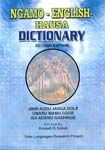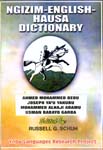Dictionaries of the Yobe Languages
The major project of the Yobe Languages Research Project has been the production of dictionaries for the Chadic languages indigenous to Yobe State. There are seven dictionaries: Bade (Gashua dialect), Bade (Western dialect), Bole, Duwai, Karekare, Ngamo, and Ngizim. Each dictionary contains the following sections:
- Introduction: a brief background on the sources of the information contained in the dictionary, comments on orthography, description the information contained in entries, acknowledgments, a list of Hausa words used in English definitions where English words of appropriate meaning are lacking, abbreviations, and table of contents.
- Language-English-Hausa Dictionary: Entries with headwords in the respective languages, grammatical category (including gender of nouns for languages where gender is relevant and classes of verbs), noun plurals for entries where plurals were collected, verbal nouns of all verbs, English definition(s), and Hausa glosses. The 2009 second editions (see below) have examples of use with English translation, morphological and grammatical information that is not immediately evident from the head entry, and, for some languages, phonological information that is not evident in the head entry alone.
- English-Language Wordlist: A wordlist of English words and Language equivalents. This is meant mainly as an index to the words in the Language-English-Hausa section. There has been no attempt to create a comprehensive list of English words with definitions in the language, and entries contain no information other than an English headword and one or more approximate equivalents in the Language. Where warranted, words from the target language are grouped under a general heading rather than as separate English-Language entries. In particular, there is a single entry for trees, one for grasses, and one for plants that count neither as trees or grasses. There is a single heading for all ideophones. Likewise, “pots”, “mats”, and several other such categories group the relevant words from the language.
- Hausa-Language Wordlist: Like the English-Language Wordlist, this is an index to the Language-English-Hausa Dictionary, with one-to-one Hausa to Language equivalents. The Hausa-Language section is even less comprehensive than the English-Language section. Though all the project participants were fluent speakers of Hausa, none were native speakers, so a Hausa definition was simply omitted where a fairly simple one-word translation was not readily available. Hausa glossing is one of the weaker points of the dictionaries, and one would would like more complete and better verified Hausa glossing. This will be for future generations of users.
First editions of all the dictionaries except that for Duwai were published in 2004. These were really extended wordlists, with no examples of use and little grammatical information other than a grammatical category label, plurals for nouns and adjectives, and verbal nouns for verbs. All the dictionaries except for Bade (Gashua dialect) have been published in second editions in 2009. In addition to being significantly expanded in terms of numbers of head entries, the second editions come closer to being real dictionaries, with more refined English definitions, extensive examples of use, and grammatical and phonological information. Many corrections have been made to the 2004 versions, ranging from typos to outright errors in definitions or headword forms. Unfortunately, given lack of time and resources for the thorough proofreading and checking that would be necessary to eliminate all solecisms, many undoubtedly remain.
All editions of the dictionaries have been published in Potiskum, Yobe State, printed by Ajami Press for local sale and distribution. Print copies are essentially unavailable outside Nigeria, but the downloadable PDF versions are identical in content and formatting.
Download the dictionaries
The links below will download PDF files of the dictionaries. The Language-English-Hausa Dictionaries include the introduction as well as the dictionary itself. The English-Language and Hausa-Language Wordlists are presented as separate files but are paginated continuing from the dictionaries.

Bade(Gashua)-English-Hausa Dictionary (2004 edition) (1.5 MB)
English-Bade (Gashua) Wordlist (372 K)
Hausa-Bade (Gashua) Wordlist (416 K)
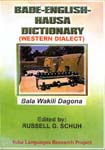
- Bade(Western)-English-Hausa Dictionary (2nd edition, 2009) (3.2 MB)
- English-Bade (Western) Wordlist (724 K)
- Hausa-Bade (Western) Wordlist (728 K)
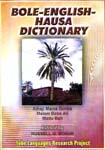 Bole Dictionary 2004
Bole Dictionary 2004
Bole-English-Hausa Dictionary (2nd edition, 2009) (5.1 MB)
English-Bole Wordlist (1 MB)
Hausa-Bole Wordlist (1 MB)
 Duwai-English-Hausa Dictionary 2009
Duwai-English-Hausa Dictionary 2009
- Duwai-English-Hausa Dictionary (1st edition, 2009) (1.7 MB)
- English-Duwai Wordlist (500 K)
- Hausa-Duwai Wordlist (476 K)
-

Karekare-English-Hausa Dictionary 2004 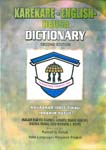
Karekare-English-Hausa Dictionary 2009
- Karekare-English-Hausa Dictionary (2nd edition, 2009) (2.3 MB)
- English-Karekare Wordlist (588 K)
- Hausa-Karekare Wordlist (584 K)
- Ngamo-English-Hausa Dictionary (2nd edition, 2009) (3.1 MB)
- English-Ngamo Wordlist (732 K)
- Hausa-Ngamo Wordlist (708 K)
- Ngizim-English-Hausa Dictionary (2nd edition, 2009) (4.5 MB)
- English-Ngizim Wordlist (904 K)
- Hausa-Ngizim Wordlist (844 K)
Comparing the 2004 and 2009 Editions
To give a rough idea of the expansion in sizes of the dictionaries between the first and second editions, here are the raw numbers for headwords in the databases from which the dictionaries were compiled:
| 2004 database | 2009 database | No. added | % increase | |
| Bade (Gashua) | 2688 | 2704 | 16 | .6% |
| Bade (Western) | 3002 | 3248 | 246 | 8.2% |
| Bole | 4156 | 4843 | 687 | 16.5% |
| Duwai | 1007 | 1588 | 581 | 57.6% |
| Karekare | 2297 | 2588 | 291 | 12.7% |
| Ngamo | 2396 | 3446 | 1050 | 43.8% |
| Ngizim | 3607 | 4230 | 623 | 17.3% |
These figures represent the number of records in the respective databases, though not necessarily the number of distinct lexical items. For example, in Bole many words have alternate pronunciations with initial s- ~ sh-. These variants are not distinct words, but they have to be entered as separate records in the database because they would not be near each other in the alphabetical listing. All the languages have situations like this, but they probably do not account for more than 100-200 records for any language. On the other hand, there are many items that probably deserve separate lexical entries but that are not listed separately. This is particularly true for verbal nouns that carry meanings that are not fully predictable from the meaning of the verb and/or which would not fall next to the verb in alphabetical listing. For example, all the Bole-Tangale languages have CeCe verbal nouns for CaCa class B verbs. Not only would the verbal nouns not be alphabetized next to the verb, but they sometimes have idiosyncratic meanings. Very few of these are listed as separate entries, though dictionaries such as the Hausa dictionaries would give separate entries in comparable cases. In short, despite fact that some of the records counted in the figures above are “duplicates”, overall, the numbers are probably considerable undercounts of the number of items found in the dictionaries that would merit separate entries but are “hidden” within records of related headwords.
A few new words that came up during work on Duwai were added to the Gashua Bade database, though a new edition of the Gashua Bade dictionary was not produced. Although no Duwai dictionary was produced in 2004, Russell G. Schuh had made a database of Duwai lexical material collected in the 1970’s, which served as a baseline comparable to that for the other 2004 databases and which was the base to which items that appeared in the 2009 dictionary were added. The Ngamo dictionaries combine the Yaya and Gudi dialects. The numbers for both years comprise all records with a headword entry for the Gudi dialect (many of which also included a Yaya headword) plus all the entries for Yaya where there was no Gudi counterpart, either because a word of equivalent meaning was not collected in Gudi or the word in Yaya was so different from the Gudi equivalent that they appeared at different places in the alphabetical order. Russell G. Schuh did not work actively on the Yaya dialect in 2007-2009, so the added items are 100% from the Gudi dialect. Numbers for the Gudi dialect alone are 1791 in 2004 vs. 2841 in 2009 (1050 new Gudi items, a 58.6% increase), attesting to the very productive work done by the Ngamo team in assembling words. The Bole and Ngizim teams showed great resourcefulness as well in finding new items to add to their considerably larger starting base.
Click here to return to the main page of the Yobe Languages Research Project.




